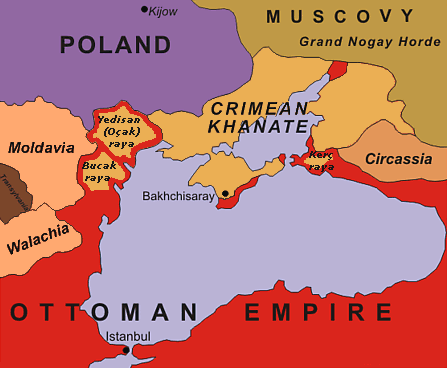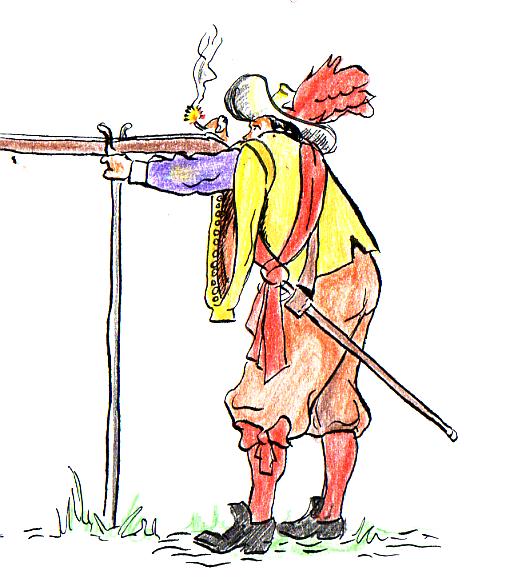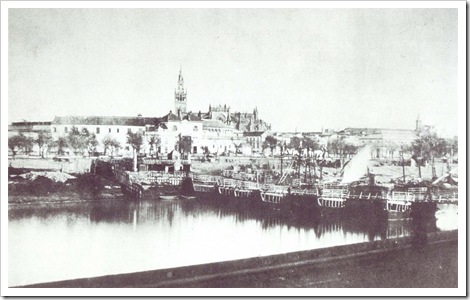|
Siege Of Silistra (1773)
The siege of Silistra was a military siege undertaken by Russia between 18 and 29 June 1773 against the Ottoman city of Silistria. The siege was an important phase of the Russo-Turkish War (1768–1774), and resulted in an Ottoman victory. Prelude In 1773, Catherine the Great ordered for Pyotr Rumyantsev to march with his army onto Silistra to pressure the Ottoman Empire into peace. With this, he crossed the Danube with a tens-of-thousands-strong force after a pontoon bridge was built across the Galitsa. Grigory Potemkin and Otto Weismann's forces were at the front of this army. Rumyantsev ordered Major-general to have roads built out to Silistra. On 12 June, Potemkin and Weismann were sent in two columns towards Silistra. They were both under the command of . There was constant fighting between Ottoman and Russian troops before they reached the fortress on 15 June. Stupishin sent a letter the same day to Serasker Halıcı Osman Pasha (the ethnically Armenian pasha defendi ... [...More Info...] [...Related Items...] OR: [Wikipedia] [Google] [Baidu] |
Russo-Turkish War (1768–1774)
The Russo-Turkish wars ( ), or the Russo-Ottoman wars (), began in 1568 and continued intermittently until 1918. They consisted of twelve conflicts in total, making them one of the longest series of wars in the history of Europe. All but four of these wars ended in losses for the Ottoman Empire, which was undergoing a period of stagnation and decline. Conversely, they showcased the ascendancy of the Russian Empire as a significant European power after Peter the Great oversaw extensive modernization efforts in the early 18th century. Ultimately, however, the end of the Russo-Turkish wars came about with the dissolution of the two belligerents' respective states as a consequence of World War I: the Russian Empire collapsed in 1917 and was ultimately succeeded by the Union of Soviet Socialist Republics in 1922; while the Ottoman Empire was partitioned between 1918 and 1922 and succeeded by the Republic of Turkey in 1923. History Initial and intermediate phases (1568–1739) ... [...More Info...] [...Related Items...] OR: [Wikipedia] [Google] [Baidu] |
Siege
A siege () . is a military blockade of a city, or fortress, with the intent of conquering by attrition, or by well-prepared assault. Siege warfare (also called siegecrafts or poliorcetics) is a form of constant, low-intensity conflict characterized by one party holding a strong, static, defensive position. Consequently, an opportunity for negotiation between combatants is common, as proximity and fluctuating advantage can encourage diplomacy. A siege occurs when an attacker encounters a city or fortress that cannot be easily taken by a quick assault, and which refuses to surrender. Sieges involve surrounding the target to block provision of supplies and reinforcement or escape of troops (a tactic known as "investment"). This is typically coupled with attempts to reduce the fortifications by means of siege engines, artillery bombardment, mining (also known as sapping), or the use of deception or treachery to bypass defenses. Failing a military outcome, sieges can often be ... [...More Info...] [...Related Items...] OR: [Wikipedia] [Google] [Baidu] |
Kabardia
The Grand Principality of Great Kabarda, also known as East Circassia or Kabardia (), was a historical country in the North Caucasus corresponding partly to modern-day Kabardino-Balkaria. It existed as a political community from the fifteenth century until it came under Russian control in the early nineteenth century after the Russo-Circassian War. Geography and peoples The Kabardians are the eastern branch of the Circassian nation. To the north were the Nogai steppe nomads, vassals of the Crimean Khanate. To the west were the Abazins, the Besleney, another Circassian tribe. In the east the Kabardians were sometimes in contact with the Kumyks. The country's boundaries fluctuated, as did its political unity and degree of control over outlying areas. The core of Kabardia was Great Kabardia which extended from somewhat east of the north-flowing part of the Kuban River to somewhat east of the north-flowing part of the Terek River. To the east was Lesser Kabardia between th ... [...More Info...] [...Related Items...] OR: [Wikipedia] [Google] [Baidu] |
Musketeer
A musketeer ( ) was a type of soldier equipped with a musket. Musketeers were an important part of early modern warfare, particularly in Europe, as they normally comprised the majority of their infantry. The musketeer was a precursor to the rifleman. Muskets were replaced by breech loading rifles as the almost universal firearm for modern armies during the period 1850 to 1870. The traditional designation of "musketeer" for an infantry private survived in the Imperial German Army until World War I. Historical antecedents The hand cannon was invented in Song dynasty China in the 12th century and was in widespread use there in the 13th century. It spread westward across Asia during the 14th century. The hand cannon evolved into the arquebus that appeared in Europe and the Ottoman Empire during the 15th century. The term musket was originally used to describe a heavy arquebus capable of penetrating heavy armor. Although this heavy version of the musket fell out of use after the mid ... [...More Info...] [...Related Items...] OR: [Wikipedia] [Google] [Baidu] |
Grenadier
A grenadier ( , ; derived from the word ''grenade'') was historically an assault-specialist soldier who threw hand grenades in siege operation battles. The distinct combat function of the grenadier was established in the mid-17th century, when grenadiers were recruited from among the strongest and largest soldiers. By the 18th century, the grenadier dedicated to throwing hand grenades had become a less necessary specialist, yet in battle, the grenadiers were the physically robust soldiers who led vanguard assaults, such as storming fortifications in the course of siege warfare. Certain countries such as France ( Grenadiers à Cheval de la Garde Impériale) and Argentina ( Regiment of Mounted Grenadiers) established units of Horse Grenadiers, and for a time the British Army had Horse Grenadier Guards. Like their infantry grenadier counterparts, these horse-mounted soldiers were chosen for their size and strength (heavy cavalry). In modern warfare, a grenadier is a specially tr ... [...More Info...] [...Related Items...] OR: [Wikipedia] [Google] [Baidu] |
Redoubt
A redoubt (historically redout) is a Fortification, fort or fort system usually consisting of an enclosed defensive emplacement outside a larger fort, usually relying on Earthworks (engineering), earthworks, although some are constructed of stone or brick. It is meant to protect soldiers outside the main defensive line and can be a permanent structure or a hastily constructed temporary fortification. The word means "a place of retreat". Redoubts were a component of the military strategies of most European empires during the colonial era, especially in the outer works of Vauban-style fortresses made popular during the 17th century, although the concept of redoubts has existed since medieval times. A redoubt differs from a redan in that the redan is open in the rear, whereas the redoubt was considered an enclosed work. Historically important redoubts English Civil War During the English Civil War, redoubts were frequently built to protect older fortifications from the more effe ... [...More Info...] [...Related Items...] OR: [Wikipedia] [Google] [Baidu] |
Cavalry
Historically, cavalry (from the French word ''cavalerie'', itself derived from ''cheval'' meaning "horse") are groups of soldiers or warriors who Horses in warfare, fight mounted on horseback. Until the 20th century, cavalry were the most mobile of the combat arms, operating as light cavalry in the roles of reconnaissance, Screening (tactical), screening, and skirmisher, skirmishing, or as heavy cavalry for decisive economy of force and shock attacks. An individual soldier in the cavalry is known by a number of designations depending on era and tactics, such as a cavalryman, Equestrianism, horseman, trooper (rank), trooper, cataphract, knight, Drabant Corps of Charles XII, drabant, hussar, uhlan, mamluk, cuirassier, lancer, dragoon, samurai or horse archer. The designation of ''cavalry'' was not usually given to any Military animal, military forces that used other animals or platforms for mounts, such as chariots, Camel cavalry, camels or War elephant, elephants. Infantry who m ... [...More Info...] [...Related Items...] OR: [Wikipedia] [Google] [Baidu] |
Armenians
Armenians (, ) are an ethnic group indigenous to the Armenian highlands of West Asia.Robert Hewsen, Hewsen, Robert H. "The Geography of Armenia" in ''The Armenian People From Ancient to Modern Times Volume I: The Dynastic Periods: From Antiquity to the Fourteenth Century''. Richard G. Hovannisian (ed.) New York: St. Martin's Press, 1997, pp. 1–17 Armenians constitute the main demographic group in Armenia and constituted the main population of the breakaway Republic of Artsakh until their Flight of Nagorno-Karabakh Armenians, subsequent flight due to the 2023 Azerbaijani offensive in Nagorno-Karabakh, 2023 Azerbaijani offensive. There is a large Armenian diaspora, diaspora of around five million people of Armenian ancestry living outside the Republic of Armenia. The largest Armenian populations exist in Armenians in Russia, Russia, the Armenian Americans, United States, Armenians in France, France, Armenians in Georgia, Georgia, Iranian Armenians, Iran, Armenians in Germany, ... [...More Info...] [...Related Items...] OR: [Wikipedia] [Google] [Baidu] |
Serasker
''Serasker'', or ''seraskier'' (; ), is a title formerly used in the Ottoman Empire for a vizier who commanded an army. Following the suppression of the Janissaries in 1826, Sultan Mahmud II transferred the functions of the old Agha of the Janissaries to the ''serasker''. The latter now became a distinct office at the head of the Ottoman military, combining the functions of a commander-in-chief and a minister of war. He also took over the Janissary Agha's former duties regarding the upkeep of order in Istanbul. Indeed, as the police system developed and expanded with the empire's progressive centralization, it became one of the main duties of the ''serasker'' until 1845, when policing became a separate agency. The seat of the ''serasker'' and his department (''bab-i seraskeri'', or ''serasker kapısı''—"Gate of the ''serasker''") initially was in the Eski Saray, but these functions transferred to dedicated buildings in 1865. In 1879 the office was renamed to Ministry of W ... [...More Info...] [...Related Items...] OR: [Wikipedia] [Google] [Baidu] |
Pontoon Bridge
A pontoon bridge (or ponton bridge), also known as a floating bridge, is a bridge that uses float (nautical), floats or shallow-draft (hull), draft boats to support a continuous deck for pedestrian and vehicle travel. The buoyancy of the supports limits the maximum load that they can carry. Most pontoon bridges are temporary and used in wartime and civil emergencies. There are permanent pontoon bridges in civilian use that can carry highway traffic; generally, the relatively high potential for collapse and sinking (e.g. due to waves and collisions) and high continuous maintenance costs makes pontoons unattractive for most civilian construction. Permanent floating bridges are useful for sheltered water crossings if it is not considered economically feasible to suspend a bridge from anchored Pier (architecture), piers (such as in deep water). Such bridges can require a section that is elevated or can be raised or removed to allow waterborne traffic to pass. Notable permanent pontoo ... [...More Info...] [...Related Items...] OR: [Wikipedia] [Google] [Baidu] |
Danube
The Danube ( ; see also #Names and etymology, other names) is the List of rivers of Europe#Longest rivers, second-longest river in Europe, after the Volga in Russia. It flows through Central and Southeastern Europe, from the Black Forest south into the Black Sea. A large and historically important river, it was once a frontier of the Roman Empire. In the 21st century, it connects ten European countries, running through their territories or marking a border. Originating in Germany, the Danube flows southeast for , passing through or bordering Austria, Slovakia, Hungary, Croatia, Serbia, Romania, Bulgaria, Moldova, and Ukraine. Among the many List of cities and towns on the river Danube, cities on the river are four national capitals: Vienna, Bratislava, Budapest, and Belgrade. Its drainage basin amounts to and extends into nine more countries. The Danube's longest headstream, the Breg (river), Breg, rises in Furtwangen im Schwarzwald, while the river carries its name from its ... [...More Info...] [...Related Items...] OR: [Wikipedia] [Google] [Baidu] |
Continuum International Publishing Group
Continuum International Publishing Group was an academic publisher of books with editorial offices in London and New York City. It was purchased by Nova Capital Management in 2005. In July 2011, it was taken over by Bloomsbury Publishing. , all new Continuum titles are published under the Bloomsbury name (under the imprint Bloomsbury Academic). History Continuum International was created in 1999 with the merger of the Cassell academic and religious lists (including Geoffrey Chapman, Mansell, Mowbray, Pinter, and Leicester University Press imprints) and the Continuum Publishing Company, founded in New York in 1980. The academic publishing programme was focused on the humanities, especially the fields of philosophy, film and music, literature, education, linguistics, theology, and biblical studies. Continuum published Paulo Freire's seminal '' Pedagogy of the Oppressed'' and music criticism series '' 33⅓''. Continuum acquired Athlone Press, which was founded in 1948 as the U ... [...More Info...] [...Related Items...] OR: [Wikipedia] [Google] [Baidu] |







